NHTSA Form 1675 MMUCC Survey B
Model Minimum Uniform Crash Criteria
NHTSA Form 1675_MMUCC Survey B Final
OMB: 2127-0759
OMB Control No. 2127-xxxx
Expiration Date xx/xx/xxxx
MMUCC Evaluation Survey B
Introduction
The National Highway Traffic Safety Administration (NHTSA) is seeking feedback from law enforcement officers on the feasibility of collecting the crash data described in the Model Minimum Uniform Crash Criteria (MMUCC) Guideline, fifth edition (DOT HS 812 433, July 2017). As a law enforcement officer who responds to crashes and writes crash reports, your participation is important to help NHTSA identify crash data elements and concepts that can be accurately collected and others that are flawed and require revision or elimination. All responses are anonymous and will be analyzed in the aggregate. The information you provide will inform the content of the next edition of MMUCC. We estimate that it will take you approximately 60 minutes to complete the survey. NHTSA will publish a summary of this research in an appendix to the next edition of MMUCC in 2024.
This collection of information is voluntary and will be used to identify problematic crash data elements, and concepts in MMUCC. A federal agency may not conduct or sponsor, and a person is not required to respond to, nor shall a person be subject to a penalty for failure to comply with, a collection of information subject to the requirements of the Paperwork Reduction Act unless that collection of information displays a current valid OMB Control Number. The OMB Control Number for this information collection is XXXXX. Public reporting for this collection of information is estimated to be approximately 60 minutes per response, including the time for reviewing instructions, and completing and reviewing the collection of information. All responses to this collection of information are voluntary. Send comments regarding this burden estimate or any other aspect of this collection of information, including suggestions for reducing this burden, to: Information Collection Clearance Officer, National Highway Traffic Safety Administration, 1200 New Jersey Ave, S.E., Washington, DC, 20590.
Directions
In the following exercises, several crash scenarios are described that relate to a set of MMUCC crash data elements. Select the most appropriate response for each identified crash data element in the scenarios. Please answer each question to the best of your ability.
Scenario 1:
Complete the data elements based on the following scenario and diagram.
The driver of Unit 2 was standing in the roadway in front of his disabled vehicle. The driver of Unit 1 didn’t see Unit 2 until it was too late and impacted the rear of Unit 2. The impact pushed Unit 2 into the driver, causing severe injuries.

Person Type (Driver of Unit 2)
Element Definition: Type of person involved in a crash.
Driver
Passenger
Occupant of Motor Vehicle Not In-Transport
Bicyclist
Other Cyclist
Pedestrian
Other Pedestrian (wheelchair, person in a building, skater, personal conveyance, etc.)
Occupant of a Non-Motor Vehicle Transportation Device
Unknown Type of Non-Motorist
Unknown
Motor Vehicle Unit Type (Unit 2)
Element Definition: Motor vehicle unit type assigned to uniquely identify each motor vehicle involved in the crash.
Motor Vehicle In-Transport
Parked Motor Vehicle
Working Motor Vehicle
Attempted Avoidance Maneuver (Unit 1)
Element Definition: This element identifies movements/actions taken by the driver after the driver realizes there is an impending danger. This element assesses what the driver action was in response to his/her realization.
No Driver Present/Unknown if Driver Present
Accelerating and Steering Left
Accelerating and Steering Right
Braking and Steering Left
Braking and Steering Right
Braking (Lockup)
Braking (Lockup Unknown)
Braking (No Lockup)
No Avoidance Maneuver
Releasing Brakes
Steering Left
Steering Right
Lay Down Motorcycle
Other Actions
Unknown
Large Vehicle Questions
Complete the data elements for the following vehicle.
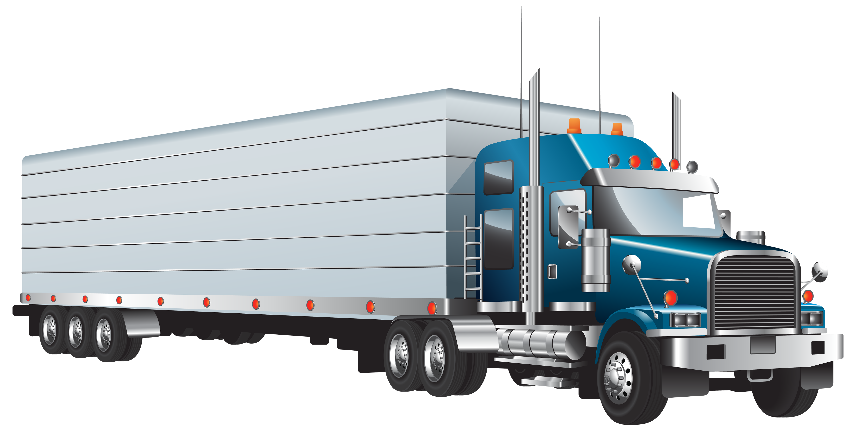
Vehicle Configuration
Element Definition: Indicates the general configuration of this motor vehicle.
Vehicle 10,000 lbs. or Less Placarded for Hazardous Materials
Bus/Large Van (seats for 9-15 occupants, including driver)
Bus (seats more than 15 occupants, including driver)
Single-Unit Truck (2-axle and GVWR > 10,000 lbs.)
Single-Unit Truck (3 or more axles)
Truck Pulling Trailer(s)
Truck Tractor (Bobtail)
Truck Tractor/Semi-Trailer
Truck Tractor/Double
Truck Tractor/Triple
Vehicle More Than 10,000 lbs., Other
Qualifying Vehicle, Unknown Configuration
Unknown
Cargo Body Type
Element Definition: The type of body for buses and trucks more than 10,000 GVWR.
No Cargo Body (bobtail, light motor vehicle with hazardous materials placard, etc.)
Bus
Auto Transporter
Cargo Tank
Concrete Mixer
Dump
Flatbed
Garbage/Refuse
Grain/Chips/Gravel
Intermodal Container Chassis
Log
Pole-Trailer
Van/Enclosed Box
Vehicle Towing Another Vehicle
Not Applicable (motor vehicle 10,000 lbs. or less, not displaying hazardous materials placard)
Other
Unknown
Scenario 2:
Complete the data elements based on the following scenario.
The driver of Unit 1 was transported to the hospital before you arrived at the scene. You have confirmation from other officers that the driver was injured in the crash, but you don’t know the severity of the injury or why the person was transported to the hospital.
Injury Status
Element Definition: The injury severity level for a person involved in a crash. The determination of which attribute to assign should be based on the latest information available at the time the report is completed, except as described below for fatal Injuries.
(K) Fatal Injury
(A) Suspected Serious Injury
(B) Suspected Minor Injury
(C) Possible Injury
(O) No Apparent Injury
Scenario 3:
Complete the following data elements for Unit 1 in this example.
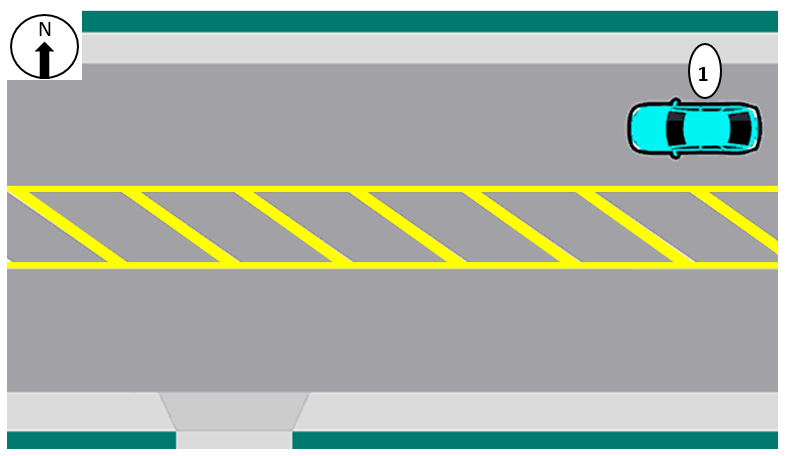
Total Lanes in Roadway - Through Lanes
Element Definition: Total number of lanes in the roadway on which this Motor Vehicle was traveling. Through lanes also include shared through/turn lanes but exclude turn-only lanes’ auxiliary lanes, such as collector-distributor lanes, weaving lanes, frontage road lanes, parking lanes, acceleration/deceleration lanes, toll collection lanes, and truck climbing lanes. Total lanes are collected in two parts as total through lanes and total auxiliary lanes.
0 Lanes
1 Lane
2 Lanes
3 Lanes
4 Lanes
5 or more Lanes
Total Lanes in Roadway - Auxiliary Lanes
Element Definition: Total number of lanes in the roadway on which this Motor Vehicle was traveling. Through lanes also include shared through/turn lanes but exclude turn-only lanes’ auxiliary lanes, such as collector-distributor lanes, weaving lanes, frontage road lanes, parking lanes, acceleration/deceleration lanes, toll collection lanes, and truck climbing lanes. Total lanes are collected in two parts as total through lanes and total auxiliary lanes.
0 Lanes
1 Lane
2 Lanes
3 Lanes
4 Lanes
5 or more Lanes
Trafficway Description, Subfield 1: Travel Directions
Element Definition: Indication of whether the trafficway for this vehicle is divided, whether it serves one-way or two-way traffic, and the type of lane this vehicle was using. Subfield 1 identifies whether the trafficway associated with this vehicle serves one-way or two-way traffic.
One-Way
Two-Way
Trafficway Description, Subfield 2: Divided?
Element Definition: Indication of whether the trafficway for this vehicle is divided, whether it serves one-way or two-way traffic, and the type of lane this vehicle was using. Subfield 2 identifies whether or not the trafficway for this vehicle is divided.
Not Divided
Not Divided, with a Continuous Left-Turn Lane
Divided, Flush Median (greater than 4ft wide)
Divided, Raised Median (curbed)
Divided, Depressed Median
Unknown
Scenario 4:
Complete the data elements for the following scenario and diagram.
Time of Crash: 23:16
Light Conditions: Dark-Not Lighted
For unknown reasons, Unit 1 (Non-Motorist) was laying in the westbound lane of Route 482. The driver of Unit 2 (Vehicle) did not see Unit 1 laying in the roadway. Unit 2 ran over Unit 1 and dragged Unit 1 approximately 20 feet. The driver pulled off to the shoulder and called 911. The driver stated that Unit 1 was not visible, and he didn’t know what he had struck until he got out of the car to look.

Initial Contact Point on Non-motorist (Unit 1)
Element Definition: Location of the initial harmful event on the non-motorist by the motor vehicle.
Front
Right
Rear
Left
Unknown
Non-Motorist Action/Circumstance Prior to Crash (Unit 1)
Element Definition: The action of the non-motorist immediately prior to the crash
None
Stationary and Adjacent to Roadway (e.g., Shoulder, Median, Sidewalk)
Crossing Roadway
In Roadway – Other
Waiting to Cross Roadway
Walking/Cycling Along Roadway Against Traffic (In or Adjacent to Travel Lane)
Walking/Cycling Along Roadway with Traffic (In or Adjacent to Travel Lane)
Walking/Cycling on Sidewalk
Working in Trafficway (Incident Response)
Other
Unknown
Non-Motorist Contributing Action(s)/Circumstance(s) (Unit 1)
Element Definition: The actions/circumstances of the non-motorist that may have contributed to the crash. This data element is based on the judgment of the law enforcement officer investigating the crash.
Select up to 2
None (No Improper Action)
Dart/Dash
Failure to Obey Traffic Signs, Signals, or Officer
Failure to Yield Right-Of-Way
Improper Turn/Merge
Inattentive (Talking, Eating, etc.)
In Roadway Improperly (Standing, Lying, Working, Playing)
Not Visible (Dark Clothing, No Lighting, etc.)
Wrong-Way Riding or Walking
Other
Unknown
Non-Motorist Location at Time of Crash (Unit 1)
Element Definition: The location of the non-motorist with respect to the roadway at the time of the crash.
Intersection - Marked Crosswalk
Intersection - Unmarked Crosswalk
Intersection – Other
Median/Crossing Island
Shoulder/Roadside
Travel Lane - Other Location
Other
Unknown
Scenario 5:
Complete the data elements based on the following scenario and diagram.
Unit 2, a school bus, was stopped to let children off the bus. The bus’s flashing lights and stop sign on an extended arm were employed and working properly. Unit 1 did not stop for the school bus as required by law, and struck Unit 3, a child crossing the road from the bus.

Initial Contact Point on Non-motorist (Unit 3)
Element Definition: Location of the initial harmful event on the non-motorist by the motor vehicle.
Front
Right
Rear
Left
Unknown
Non-Motorist Action/Circumstance Prior to Crash (Unit 3)
Element Definition: The action of the non-motorist immediately prior to the crash
None
Stationary and Adjacent to Roadway (e.g., Shoulder, Median, Sidewalk)
Crossing Roadway
In Roadway – Other
Waiting to Cross Roadway
Walking/Cycling Along Roadway Against Traffic (In or Adjacent to Travel Lane)
Walking/Cycling Along Roadway with Traffic (In or Adjacent to Travel Lane)
Walking/Cycling on Sidewalk
Working in Trafficway (Incident Response)
Other
Unknown
Non-Motorist Contributing Action(s)/Circumstance(s) (Unit 3)
Element Definition: The actions/circumstances of the non-motorist that may have contributed to the crash. This data element is based on the judgment of the law enforcement officer investigating the crash.
Select up to 2
None (No Improper Action)
Dart/Dash
Failure to Obey Traffic Signs, Signals, or Officer
Failure to Yield Right-Of-Way
Improper Turn/Merge
Inattentive (Talking, Eating, etc.)
In Roadway Improperly (Standing, Lying, Working, Playing)
Not Visible (Dark Clothing, No Lighting, etc.)
Wrong-Way Riding or Walking
Other
Unknown
Non-Motorist Location at Time of Crash (Unit 3)
Element Definition: The location of the non-motorist with respect to the roadway at the time of the crash.
Intersection - Marked Crosswalk
Intersection - Unmarked Crosswalk
Intersection – Other
Median/Crossing Island
Shoulder/Roadside
Travel Lane - Other Location
Other
Unknown
School Bus Related
Element Definition: Indicates whether a school bus or motor vehicle functioning as a school bus for a school-related purpose is involved in the crash. The “school bus,” with or without a passenger on board, must be directly involved as a contact motor vehicle or indirectly involved as a non-contact motor vehicle (children struck when boarding or alighting from the school bus, two vehicles colliding as the result of the stopped school bus, etc.).
No
Yes, School Bus Directly Involved
Yes, School Bus Indirectly Involved
Scenario 6:
Complete the data elements based on the following scenario and diagram.
Unit 1 (yellow vehicle) and Unit 2 (blue vehicle) were traveling on northbound June Mill Parkway, just before the overpass with Interstate 70. Unit 1 attempted to change lanes to the right and impacted the left front of Unit 2. The driver of Unit 1 claimed he did not see Unit 2 in his blind spot.
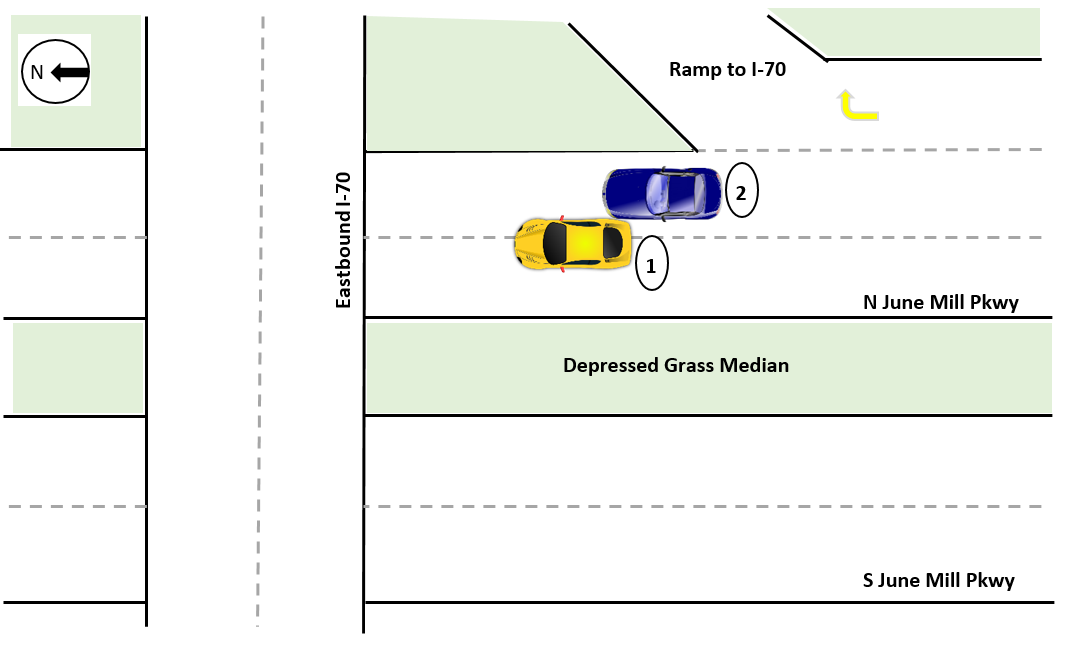
Relation to Junction
Element Definition: The coding of this data element is based on the location of the First Harmful Event of the crash. It identifies the crash’s location with respect to presence in a junction or proximity to components typically in junction or interchange areas.
Non-Junction
Acceleration/Deceleration Lane
Crossover-Related
Driveway Access or Related
Entrance/Exit Ramp or Related
Intersection or Related
Railway Grade Crossing
Shared-Use Path or Trail
Through Roadway
Other Location Not Listed Above Within an Interchange Area (median, shoulder, and roadside)
Unknown
Total Lanes in Roadway - Through Lanes (Unit 1)
Element Definition: Total number of lanes in the roadway on which this Motor Vehicle was traveling. Through lanes also include shared through/turn lanes but exclude turn-only lanes’ auxiliary lanes, such as collector-distributor lanes, weaving lanes, frontage road lanes, parking lanes, acceleration/deceleration lanes, toll collection lanes, and truck climbing lanes. Total lanes are collected in two parts as total through lanes and total auxiliary lanes.
0 Lanes
1 Lane
2 Lanes
3 Lanes
5 or more Lanes
Total Lanes in Roadway - Auxiliary Lanes (Unit 1)
Element Definition: Total number of lanes in the roadway on which this Motor Vehicle was traveling. Through lanes also include shared through/turn lanes but exclude turn-only lanes’ auxiliary lanes, such as collector-distributor lanes, weaving lanes, frontage road lanes, parking lanes, acceleration/deceleration lanes, toll collection lanes, and truck climbing lanes. Total lanes are collected in two parts as total through lanes and total auxiliary lanes.
0 Lanes
1 Lane
2 Lanes
3 Lanes
5 or more Lanes
Trafficway Description, Subfield 1: Travel Directions (Unit 1)
Element Definition: Indication of whether the trafficway for this vehicle is divided, whether it serves one-way or two-way traffic, and the type of lane this vehicle was using. Subfield 1 identifies whether the trafficway associated with this vehicle serves one-way or two-way traffic.
One-Way
Two-Way
Trafficway Description, Subfield 2: Divided (Unit 1)
Element Definition: Indication of whether the trafficway for this vehicle is divided, whether it serves one-way or two-way traffic, and the type of lane this vehicle was using. Subfield 2 identifies whether or not the trafficway for this vehicle is divided.
Not Divided
Not Divided, with a Continuous Left-Turn Lane
Divided, Flush Median (greater than 4ft wide)
Divided, Raised Median (curbed)
Divided, Depressed Median
Unknown
Driver Actions at Time of Crash (Unit 1)
Element Definition: The actions by the driver that may have contributed to the crash. This data element is based on the judgment of the law enforcement officer investigating the crash and need not match Violation Codes.
Select up to 4
No Contributing Action
Failed to Keep in Proper Lane
Failed to Yield Right-of-Way
Improper Passing
Operated Motor Vehicle in Inattentive, Careless, Negligent, or Erratic Manner
Operated Motor Vehicle in Reckless or Aggressive Manner
Other Contributing Action
Scenario 7:
Complete the data elements based on the following scenario and diagram.
Unit 1 (blue vehicle) was traveling west on Trident Rd. Unit 2 (yellow vehicle) was eastbound on Trident, and stopped for the red light at the intersection of Trident Rd. and Pine Tree Rd. Unit 3 (bicyclist) was traveling north on Pine Tree Rd., passing through the intersection with the green light. Unit 1 (blue vehicle) failed to stop at the red light, struck Unit 3 (bicyclist), then struck Unit 2 (yellow vehicle). Unit 3 (bicyclist) received major injuries. The driver of Unit 2 (yellow vehicle) also received major injuries. The driver of Unit 1 (blue vehicle) received minor injuries after the impact with Unit 2 (yellow vehicle).
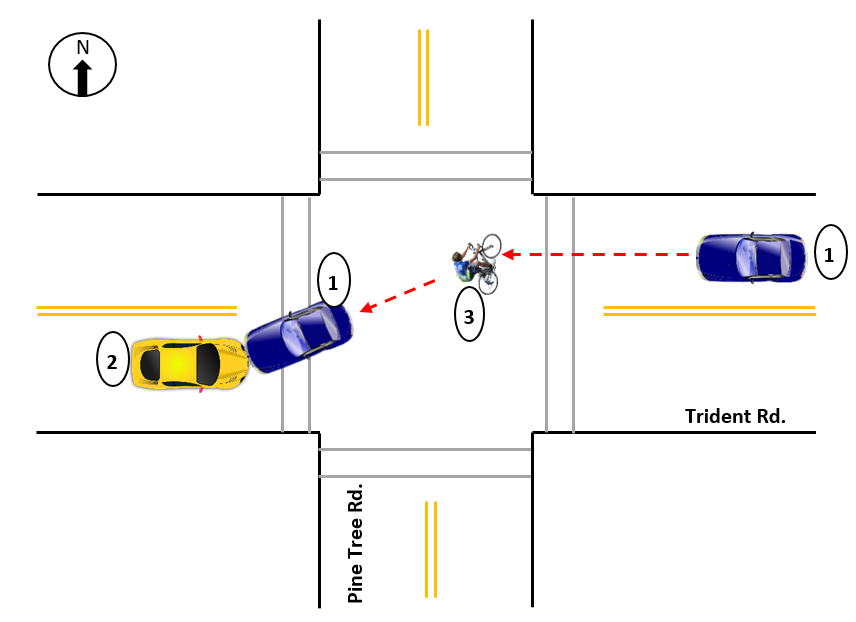
First Harmful Event
Element Definition: The first harmful event is defined as the first injury- or damage-producing event of the crash.
Motor Vehicle In-Transport
Pedalcyclist
Manner of Collision of the First Harmful Event
Element Definition: The identification of the manner in which two Motor Vehicles In-Transport initially came together without regard to the direction of force. This data element refers only to crashes where the First Harmful Event involves a collision between two Motor Vehicles In-Transport.
The First Harmful Event was Not a Collision Between Two Motor Vehicles In-Transport
Angle
Front to Front
Front to Rear
Rear to Rear
Rear to Side
Sideswipe, Opposite Direction
Sideswipe, Same Direction
Other
Unknown
Most Harmful Event for this motor vehicle (Unit 1)
Element Definition: Event that resulted in the most severe injury or, if no injury, the greatest property damage involving this motor vehicle.
Motor Vehicle In-Transport
Pedalcyclist
Format Review:
Review two different formats for the data element "Air Bag Deployed"
Element Definition: Deployment status of an air bag relative to the position in the vehicle for this occupant.
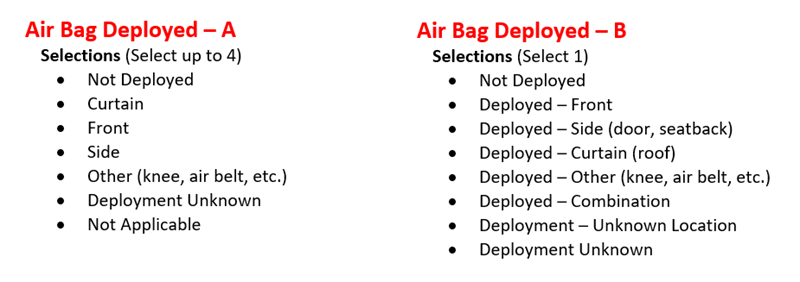
Which format would you prefer to see on a crash report form?
Air Bag Deployed – A
Air Bag Deployed - B
Explain your preference
Scenario 8:
Complete the data elements based on the following scenario and diagram.
Vehicles 1 and 2 were engaged in a race on Arbor Blvd. Vehicle 1 failed to negotiate a slight curve, ran off the road, and struck a fire hydrant. The posted speed limit on this section of Arbor Blvd. is 45 MPH. A witness at the scene described the two vehicles driving in excess of 70 MPH.
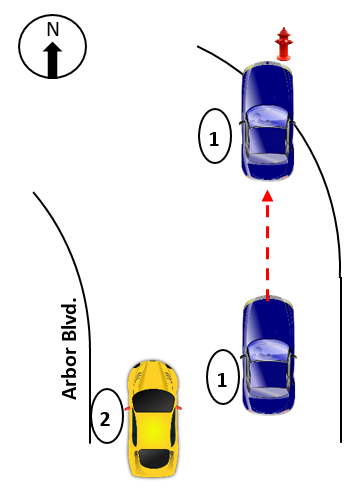
Speeding Related (Unit 1)
Element Definition: Indication of whether the investigating officer suspects that the driver involved in the crash was speeding based on verbal or physical evidence and not on speculation alone.
Note about attribute hierarchy: If more than one condition was present at the same time, select the code with the lowest value. For example, if the driver was traveling too fast for conditions AND exceeding the speed limit, select 02 (Yes, Exceeded Speed Limit), because it has a lower value (higher on the list) than 03 (Yes, Too Fast for Conditions).
00 (No)
01 (Yes, Racing)
02 (Yes, Exceeded Speed Limit)
03 (Yes, Too Fast for Conditions)
04 (Yes, Specifics Unknown)
99 (Unknown)
Scenario 9:
Complete the data elements based on the following scenario and diagram.
Unit 1 was traveling eastbound through the shopping center parking lot. Unit 2 was traveling southbound through the parking lot. There are 3 stop signs in place by the property owners. The 4th stop sign for the eastbound traffic was knocked down and laying on the ground. Unit 1 did not see the knocked down stop sign and continued into the intersection without stopping. Unit 1 struck Unit 2.
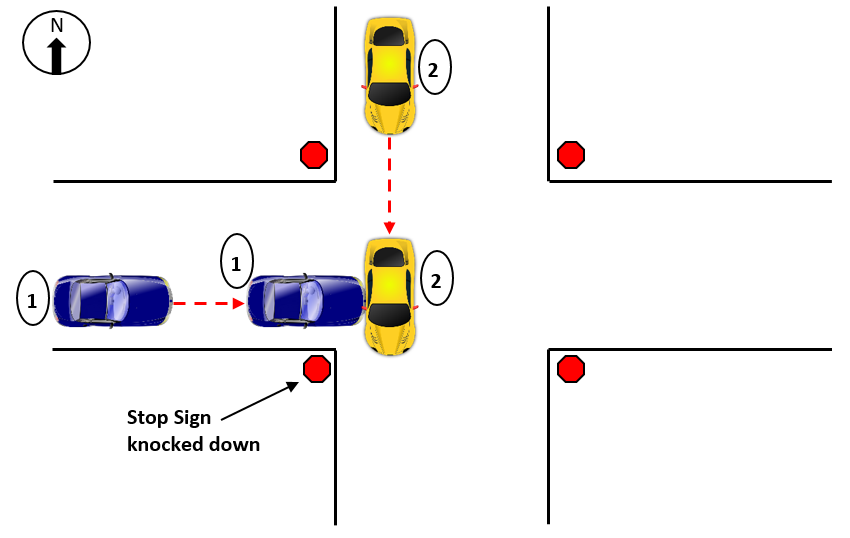
Crash Classification, Subfield 1: Ownership
Element Definition: Subfield 1: Ownership is used to identify ownership of the land where the crash occurred.
Public Property
Private Property
Crash Classification, Subfield 2: Characteristics
Element Definition: Subfield 2: Characteristics of this element is used to identify the characteristics of the crash with respect to its location on or off a trafficway.
Trafficway, On Road
Trafficway, Not on Road
Non-Trafficway
Crash Classification, Subfield 3: Secondary Crash?
Element Definition: Subfield 3: Secondary Crash? of this element includes a motor vehicle traffic crash within a traffic incident scene or within a traffic queue in either direction resulting from a prior traffic incident.
No
Yes
Traffic Control Device Type, Subfield 1: Type (Unit 1)
Element Definition: The type of traffic control device(s) (TCD) applicable to this motor vehicle at the crash location. Subfield 2 cannot be collected through linkage to the roadway system. If a signal is not flashing, it may not necessarily be considered inoperative. The unit may still be functioning correctly, but not in the time it is supposed to be flashing (e.g., Flashing School Zone Signal during school hours).
No Controls
Stop Sign
Traffic Control Device Type, Subfield 2: Are any Inoperative or Missing? (Unit 1)
Element Definition: The type of traffic control device(s) (TCD) applicable to this motor vehicle at the crash location. Subfield 2 cannot be collected through linkage to the roadway system. If a signal is not flashing, it may not necessarily be considered inoperative. The unit may still be functioning correctly, but not in the time it is supposed to be flashing (e.g., Flashing School Zone Signal during school hours).
None inoperative or missing
Stop Sign
Scenario 10:
Complete the data elements based on the following scenario and diagram.
Vehicle 1 lost control on a patch of ice, ran into a construction zone, and struck Vehicle 2 (dump truck). The construction zone was not in operation at the time and the dump truck was unoccupied.
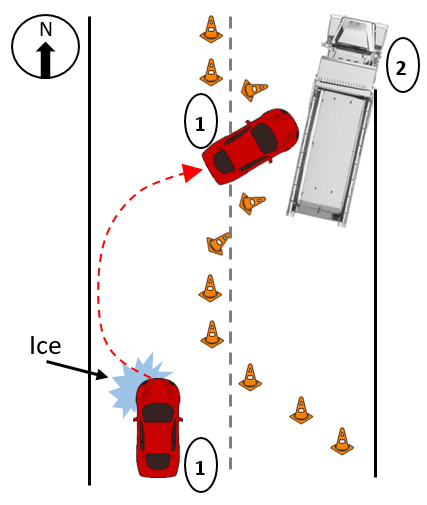
Motor Vehicle Unit Type (Unit 2)
Element Definition: Motor vehicle unit type assigned to uniquely identify each motor vehicle involved in the crash.
Motor Vehicle In-Transport
Parked Motor Vehicle
Working Motor Vehicle
Work Zone-Related, Subfield 1: Was the crash in a construction, maintenance, or utility work zone or was it related to activity within a work zone?
Element Definition: A crash that occurs in or related to a construction, maintenance, or utility work zone, whether workers were present at the time of the crash or not. “Work zone-related” crashes may also include those involving motor vehicles slowed or stopped because of the work zone, even if the First Harmful Event occurred before the first warning sign.
No
Yes
Unknown
Work Zone-Related, Subfield 2: Location of the Crash
Element Definition: A crash that occurs in or related to a construction, maintenance, or utility work zone, whether workers were present at the time of the crash or not. “Work zone-related” crashes may also include those involving motor vehicles slowed or stopped because of the work zone, even if the First Harmful Event occurred before the first warning sign.
Before the First Work Zone Warning Sign
Advance Warning Area
Transition Area
Activity Area
Termination Area
Not Applicable/Not Within or Related to a Work Zone
Work Zone-Related, Subfield 3: Type of Work Zone
Element Definition: A crash that occurs in or related to a construction, maintenance, or utility work zone, whether workers were present at the time of the crash or not. “Work zone-related” crashes may also include those involving motor vehicles slowed or stopped because of the work zone, even if the First Harmful Event occurred before the first warning sign.
Lane Closure
Lane Shift/Crossover
Work on Shoulder or Median
Intermittent or Moving Work
Other Type of Work Zone
Not Applicable/Not Within or Related to a Work Zone
Scenario 11:
For the data element "Emergency Motor Vehicle Use," select the most appropriate variable for each description.
Element Definition: Indicates operation of any motor vehicle that is legally authorized by a government authority to respond to emergencies with or without the use of emergency warning equipment, such as a police vehicle, fire truck, or ambulance while engaged in such response.
The authorized emergency vehicle has been dispatched to an incident or has initiated operation in a non-emergency mode and is not transporting passengers, such as patients or suspects. The emergency vehicle operator is not using emergency lighting, audible siren, or emergency vehicle maneuvers.
Non-Emergency Transport
Emergency Operation, Emergency Warning Equipment Not in Use
Unknown
Emergency Operation, Emergency Warning Equipment in Use
Non-Emergency, Non-Transport
Not applicable
The authorized emergency vehicle has been dispatched to an incident or has initiated an emergency operation and is using an audible siren and/or has illuminated its emergency lighting devices. The emergency vehicle operator is using or is prepared to use emergency vehicle maneuvers as allowed by State law.
Non-Emergency Transport
Emergency Operation, Emergency Warning Equipment Not in Use
Unknown
Emergency Operation, Emergency Warning Equipment in Use
Non-Emergency, Non-Transport
Not applicable
The authorized emergency vehicle has been dispatched to an incident or has initiated an emergency operation and has no emergency lighting or audible siren in use. The emergency vehicle operator may be using emergency vehicle maneuvers as allowed under State law. Examples: a police car in the last mile approaching a bank robbery; transport of a patient in an ambulance for which lights and sirens are not used per protocol.
Non-Emergency Transport
Emergency Operation, Emergency Warning Equipment Not in Use
Unknown
Emergency Operation, Emergency Warning Equipment in Use
Non-Emergency, Non-Transport
Not applicable
The authorized emergency vehicle has been dispatched to an incident or has initiated a transport-related operation in a non-emergency mode. The emergency vehicle operator is not using emergency lighting, audible siren, or emergency vehicle maneuvers. Example: transport of a suspect from one location to another or interfacility transport of a patient in an ambulance to a nursing home.
Non-Emergency Transport
Emergency Operation, Emergency Warning Equipment Not in Use
Unknown
Emergency Operation, Emergency Warning Equipment in Use
Non-Emergency, Non-Transport
Not applicable
Directions
In the following exercises you will be asked to review crash data elements and answer two questions about each.
1.) Please rate the following statements for this data element using a scale of 1-5, with 1 meaning Strongly Agree and 5 meaning Strongly Disagree.
This data element is clearly defined and understandable.
This data element can be collected at the scene of a crash.
This data element can be completed based on facts, not speculation.
This data element has a reasonable number of selections.
2.) Reflecting on your answers above, could this data element be improved? If so, how?
Please answer each question to the best of your ability. The more detailed the answer, the more helpful it will be toward improving future editions of the MMUCC guidelines.
Data Element Review: First Harmful Event
Review the data element and answer the following questions.
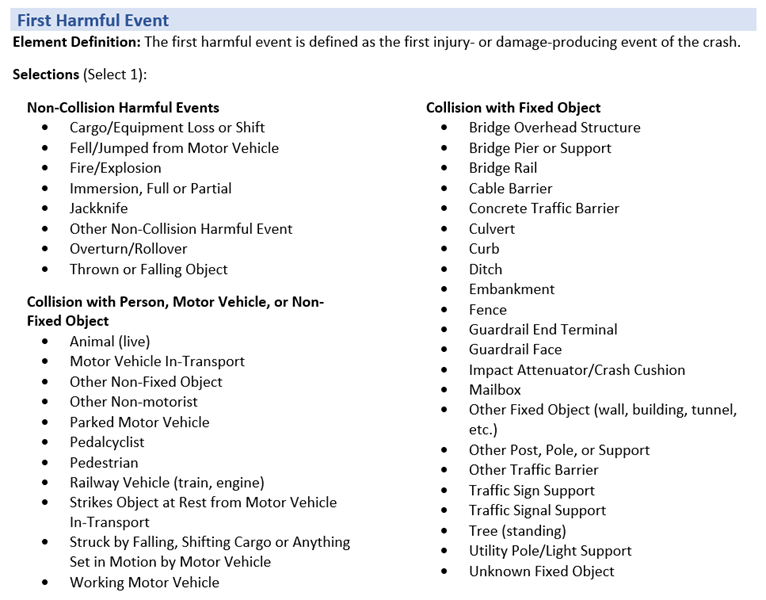
Please rate the following statements for this data element using a scale of 1-5, with 1 meaning Strongly Agree and 5 meaning Strongly Disagree.
|
1-Strongly Agree |
2-Agree |
3-Neutral |
4-Disagree |
5-Strongly Disagree |
This data element is clearly defined and understandable |
|
|
|
|
|
This data element can be collected at the scene of a crash |
|
|
|
|
|
This data element can be completed based on facts, not speculation |
|
|
|
|
|
This data element has a reasonable number of selections |
|
|
|
|
|
Reflecting on your answers above, could this data element be improved? If so, how?
Data Element Review: Air Bag Deployed
Review the data element and answer the following questions.
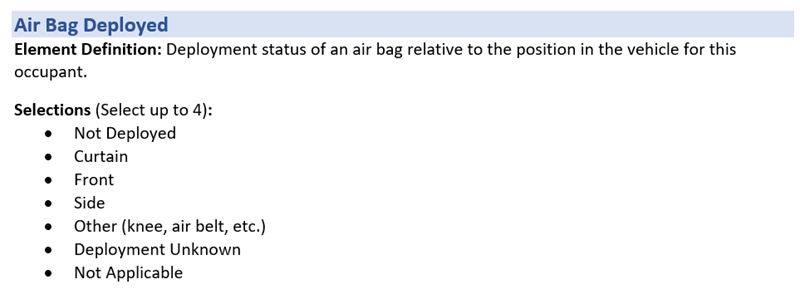
Please rate the following statements for this data element using a scale of 1-5, with 1 meaning Strongly Agree and 5 meaning Strongly Disagree.
|
1-Strongly Agree |
2-Agree |
3-Neutral |
4-Disagree |
5-Strongly Disagree |
This data element is clearly defined and understandable |
|
|
|
|
|
This data element can be collected at the scene of a crash |
|
|
|
|
|
This data element can be completed based on facts, not speculation |
|
|
|
|
|
This data element has a reasonable number of selections |
|
|
|
|
|
Reflecting on your answers above, could this data element be improved? If so, how?
Data Element Review: Person Type
Review the data element and answer the following questions.
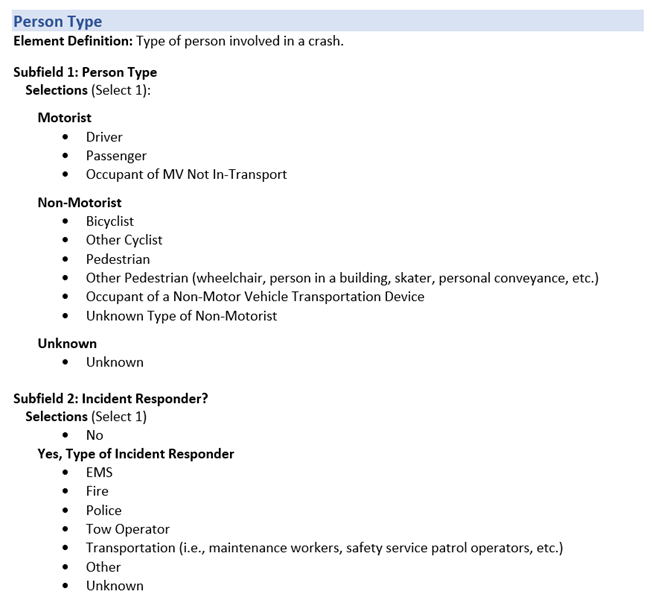
Please rate the following statements for this data element using a scale of 1-5, with 1 meaning Strongly Agree and 5 meaning Strongly Disagree.
|
1-Strongly Agree |
2-Agree |
3-Neutral |
4-Disagree |
5-Strongly Disagree |
This data element is clearly defined and understandable |
|
|
|
|
|
This data element can be collected at the scene of a crash |
|
|
|
|
|
This data element can be completed based on facts, not speculation |
|
|
|
|
|
This data element has a reasonable number of selections |
|
|
|
|
|
Reflecting on your answers above, could this data element be improved? If so, how?
Data Element Review: Relation to Junction
Review the data element and answer the following questions.

Please rate the following statements for this data element using a scale of 1-5, with 1 meaning Strongly Agree and 5 meaning Strongly Disagree.
|
1-Strongly Agree |
2-Agree |
3-Neutral |
4-Disagree |
5-Strongly Disagree |
This data element is clearly defined and understandable |
|
|
|
|
|
This data element can be collected at the scene of a crash |
|
|
|
|
|
This data element can be completed based on facts, not speculation |
|
|
|
|
|
This data element has a reasonable number of selections |
|
|
|
|
|
Reflecting on your answers above, could this data element be improved? If so, how?
Data Element Review: Non-Motorist Action/Circumstance Prior to Crash
Review the data element and answer the following questions.
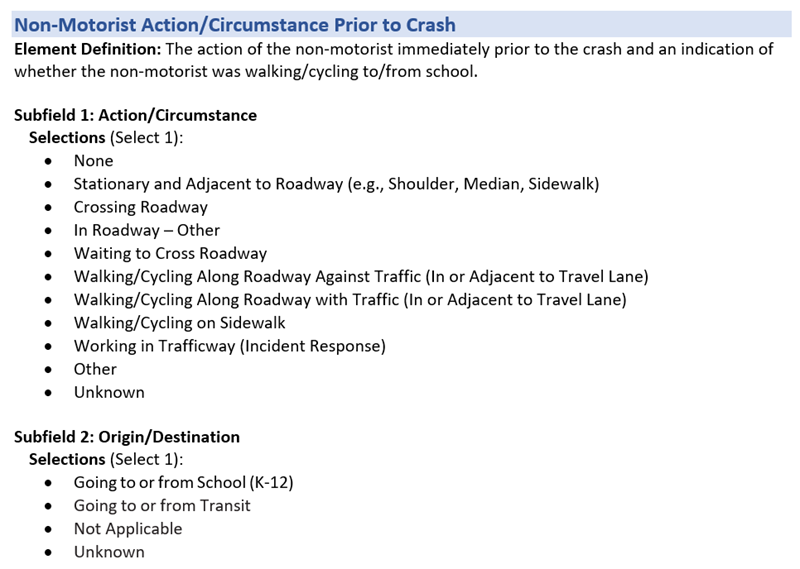
Please rate the following statements for this data element using a scale of 1-5, with 1 meaning Strongly Agree and 5 meaning Strongly Disagree.
|
1-Strongly Agree |
2-Agree |
3-Neutral |
4-Disagree |
5-Strongly Disagree |
This data element is clearly defined and understandable |
|
|
|
|
|
This data element can be collected at the scene of a crash |
|
|
|
|
|
This data element can be completed based on facts, not speculation |
|
|
|
|
|
This data element has a reasonable number of selections |
|
|
|
|
|
Reflecting on your answers above, could this data element be improved? If so, how?
Data Element Review: Driver Actions at Time of the Crash
Review the data element and answer the following questions.
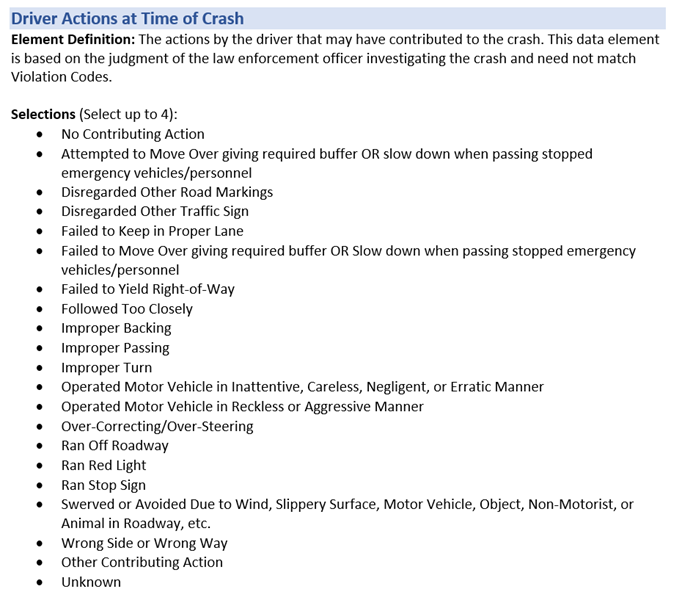
Please rate the following statements for this data element using a scale of 1-5, with 1 meaning Strongly Agree and 5 meaning Strongly Disagree.
|
1-Strongly Agree |
2-Agree |
3-Neutral |
4-Disagree |
5-Strongly Disagree |
This data element is clearly defined and understandable |
|
|
|
|
|
This data element can be collected at the scene of a crash |
|
|
|
|
|
This data element can be completed based on facts, not speculation |
|
|
|
|
|
This data element has a reasonable number of selections |
|
|
|
|
|
Reflecting on your answers above, could this data element be improved? If so, how?
Data Element Review: Injury Status
Review the data element and answer the following questions.
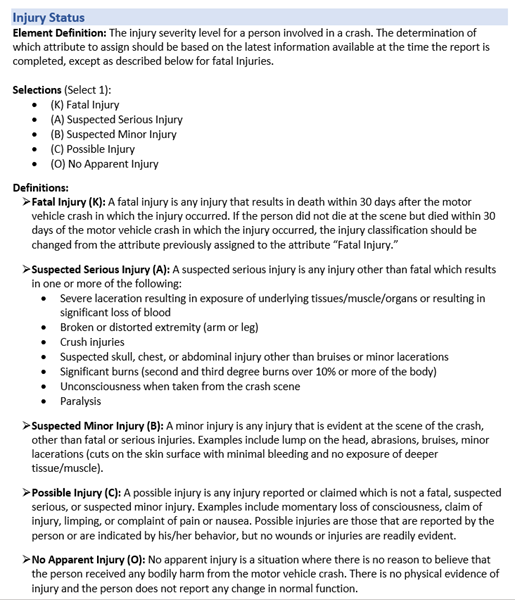
Please rate the following statements for this data element using a scale of 1-5, with 1 meaning Strongly Agree and 5 meaning Strongly Disagree.
|
1-Strongly Agree |
2-Agree |
3-Neutral |
4-Disagree |
5-Strongly Disagree |
This data element is clearly defined and understandable |
|
|
|
|
|
This data element can be collected at the scene of a crash |
|
|
|
|
|
This data element can be completed based on facts, not speculation |
|
|
|
|
|
This data element has a reasonable number of selections |
|
|
|
|
|
Reflecting on your answers above, could this data element be improved? If so, how?
Data Element Review: Initial Contact Point on Non-Motorist
Review the data element and answer the following questions.
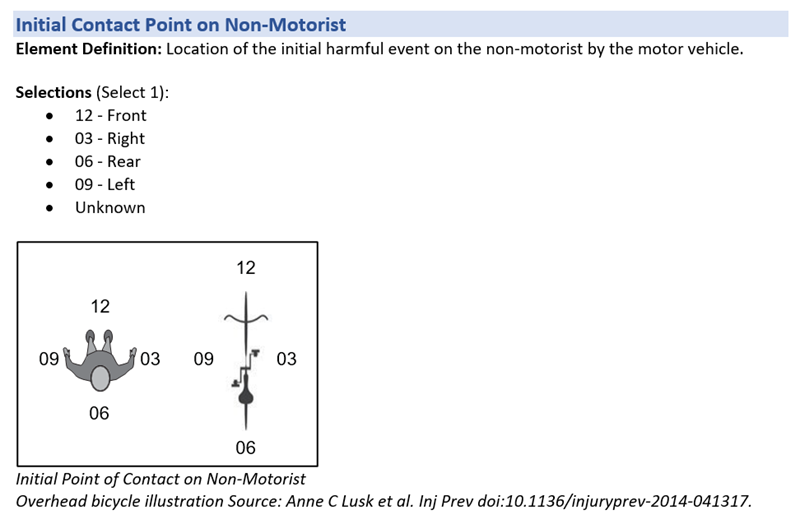
Please rate the following statements for this data element using a scale of 1-5, with 1 meaning Strongly Agree and 5 meaning Strongly Disagree.
|
1-Strongly Agree |
2-Agree |
3-Neutral |
4-Disagree |
5-Strongly Disagree |
This data element is clearly defined and understandable |
|
|
|
|
|
This data element can be collected at the scene of a crash |
|
|
|
|
|
This data element can be completed based on facts, not speculation |
|
|
|
|
|
This data element has a reasonable number of selections |
|
|
|
|
|
Reflecting on your answers above, could this data element be improved? If so, how?
Data Element Review: Manner of Collision of the First Harmful Event
Review the data element and answer the following questions.
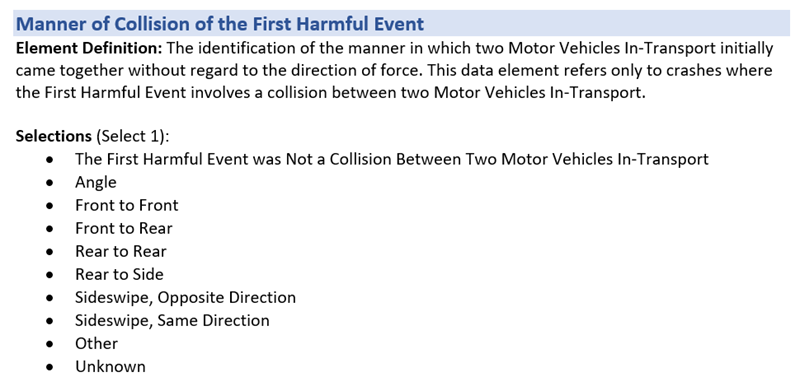
Please rate the following statements for this data element using a scale of 1-5, with 1 meaning Strongly Agree and 5 meaning Strongly Disagree.
|
1-Strongly Agree |
2-Agree |
3-Neutral |
4-Disagree |
5-Strongly Disagree |
This data element is clearly defined and understandable |
|
|
|
|
|
This data element can be collected at the scene of a crash |
|
|
|
|
|
This data element can be completed based on facts, not speculation |
|
|
|
|
|
This data element has a reasonable number of selections |
|
|
|
|
|
Reflecting on your answers above, could this data element be improved? If so, how?
Data Element Review: Most Harmful Event for this Motor Vehicle.
Review the data element and answer the following questions.
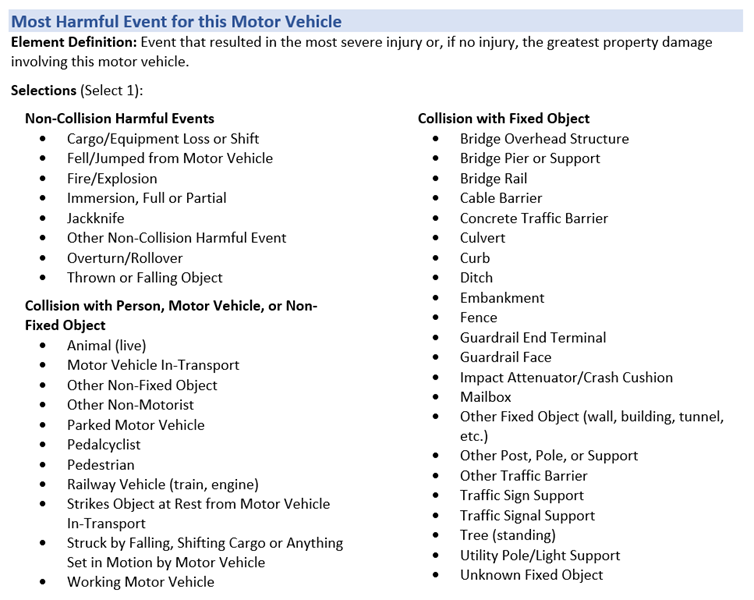
Please rate the following statements for this data element using a scale of 1-5, with 1 meaning Strongly Agree and 5 meaning Strongly Disagree.
|
1-Strongly Agree |
2-Agree |
3-Neutral |
4-Disagree |
5-Strongly Disagree |
This data element is clearly defined and understandable |
|
|
|
|
|
This data element can be collected at the scene of a crash |
|
|
|
|
|
This data element can be completed based on facts, not speculation |
|
|
|
|
|
This data element has a reasonable number of selections |
|
|
|
|
|
Reflecting on your answers above, could this data element be improved? If so, how?
Data Element Review: Speeding Related
Review the data element and answer the following questions.

Please rate the following statements for this data element using a scale of 1-5, with 1 meaning Strongly Agree and 5 meaning Strongly Disagree.
|
1-Strongly Agree |
2-Agree |
3-Neutral |
4-Disagree |
5-Strongly Disagree |
This data element is clearly defined and understandable |
|
|
|
|
|
This data element can be collected at the scene of a crash |
|
|
|
|
|
This data element can be completed based on facts, not speculation |
|
|
|
|
|
This data element has a reasonable number of selections |
|
|
|
|
|
Reflecting on your answers above, could this data element be improved? If so, how?
Data Element Review: Crash Classification
Review the data element and answer the following questions.
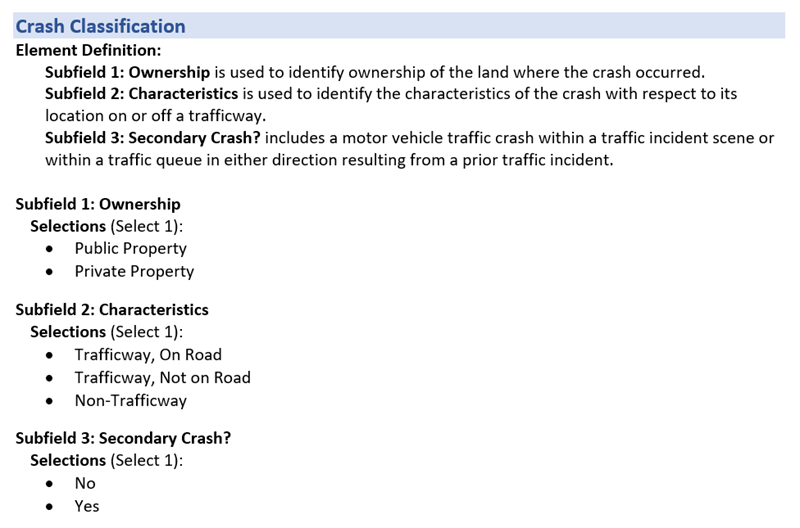
Please rate the following statements for this data element using a scale of 1-5, with 1 meaning Strongly Agree and 5 meaning Strongly Disagree.
|
1-Strongly Agree |
2-Agree |
3-Neutral |
4-Disagree |
5-Strongly Disagree |
This data element is clearly defined and understandable |
|
|
|
|
|
This data element can be collected at the scene of a crash |
|
|
|
|
|
This data element can be completed based on facts, not speculation |
|
|
|
|
|
This data element has a reasonable number of selections |
|
|
|
|
|
Reflecting on your answers above, could this data element be improved? If so, how?
Data Element Review: Emergency Motor Vehicle Use
Review the data element and answer the following questions.
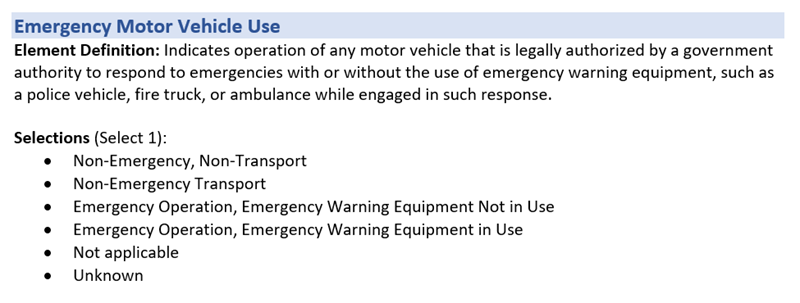
Please rate the following statements for this data element using a scale of 1-5, with 1 meaning Strongly Agree and 5 meaning Strongly Disagree.
|
1-Strongly Agree |
2-Agree |
3-Neutral |
4-Disagree |
5-Strongly Disagree |
This data element is clearly defined and understandable |
|
|
|
|
|
This data element can be collected at the scene of a crash |
|
|
|
|
|
This data element can be completed based on facts, not speculation |
|
|
|
|
|
This data element has a reasonable number of selections |
|
|
|
|
|
Reflecting on your answers above, could this data element be improved? If so, how?
Data Element Review: Traffic Control Device Type
Review the data element and answer the following questions.

Please rate the following statements for this data element using a scale of 1-5, with 1 meaning Strongly Agree and 5 meaning Strongly Disagree.
|
1-Strongly Agree |
2-Agree |
3-Neutral |
4-Disagree |
5-Strongly Disagree |
This data element is clearly defined and understandable |
|
|
|
|
|
This data element can be collected at the scene of a crash |
|
|
|
|
|
This data element can be completed based on facts, not speculation |
|
|
|
|
|
This data element has a reasonable number of selections |
|
|
|
|
|
Reflecting on your answers above, could this data element be improved? If so, how?
Data Element Review: Crash Date and Time
Review the data element and answer the following questions.
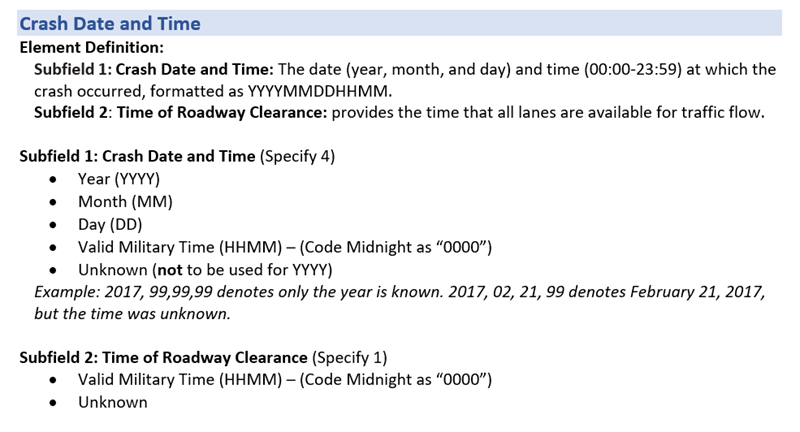
Please rate the following statements for this data element using a scale of 1-5, with 1 meaning Strongly Agree and 5 meaning Strongly Disagree.
|
1-Strongly Agree |
2-Agree |
3-Neutral |
4-Disagree |
5-Strongly Disagree |
This data element is clearly defined and understandable |
|
|
|
|
|
This data element can be collected at the scene of a crash |
|
|
|
|
|
This data element can be completed based on facts, not speculation |
|
|
|
|
|
This data element has a reasonable number of selections |
|
|
|
|
|
Reflecting on your answers above, could this data element be improved? If so, how?
Data Element Review: Law Enforcement Suspects Drug Use
Review the data element and answer the following questions.

Please rate the following statements for this data element using a scale of 1-5, with 1 meaning Strongly Agree and 5 meaning Strongly Disagree.
|
1-Strongly Agree |
2-Agree |
3-Neutral |
4-Disagree |
5-Strongly Disagree |
This data element is clearly defined and understandable |
|
|
|
|
|
This data element can be collected at the scene of a crash |
|
|
|
|
|
This data element can be completed based on facts, not speculation |
|
|
|
|
|
This data element has a reasonable number of selections |
|
|
|
|
|
Reflecting on your answers above, could this data element be improved? If so, how?
Data Element Review: Location of First Harmful Event Relative to the Trafficway
Review the data element and answer the following questions.
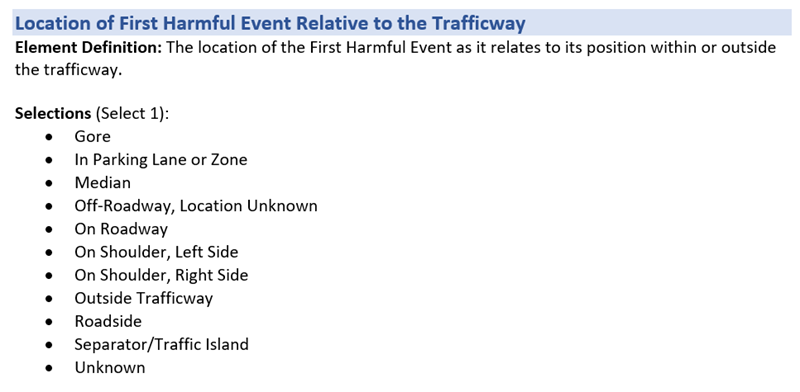
Please rate the following statements for this data element using a scale of 1-5, with 1 meaning Strongly Agree and 5 meaning Strongly Disagree.
|
1-Strongly Agree |
2-Agree |
3-Neutral |
4-Disagree |
5-Strongly Disagree |
This data element is clearly defined and understandable |
|
|
|
|
|
This data element can be collected at the scene of a crash |
|
|
|
|
|
This data element can be completed based on facts, not speculation |
|
|
|
|
|
This data element has a reasonable number of selections |
|
|
|
|
|
Reflecting on your answers above, could this data element be improved? If so, how?
Data Element Review: Motor Vehicle Maneuver/Action
Review the data element and answer the following questions.
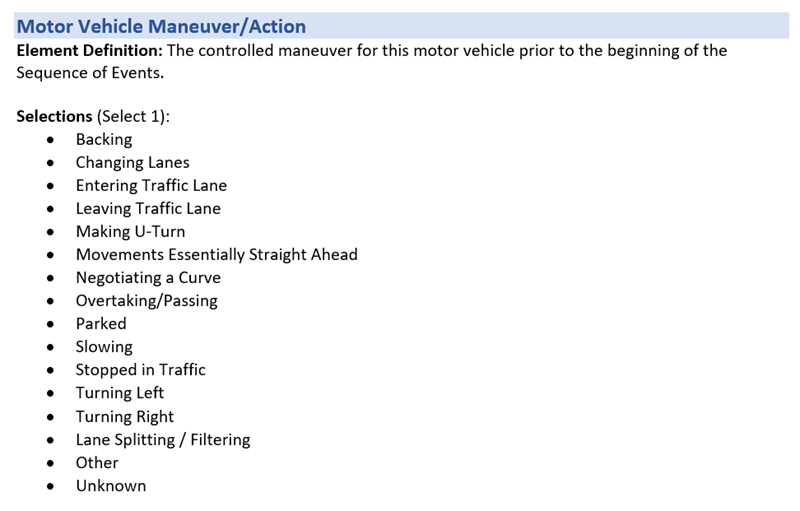
Please rate the following statements for this data element using a scale of 1-5, with 1 meaning Strongly Agree and 5 meaning Strongly Disagree.
|
1-Strongly Agree |
2-Agree |
3-Neutral |
4-Disagree |
5-Strongly Disagree |
This data element is clearly defined and understandable |
|
|
|
|
|
This data element can be collected at the scene of a crash |
|
|
|
|
|
This data element can be completed based on facts, not speculation |
|
|
|
|
|
This data element has a reasonable number of selections |
|
|
|
|
|
Reflecting on your answers above, could this data element be improved? If so, how?
Data Element Review: Roadway Alignment and Grade
Review the data element and answer the following questions.
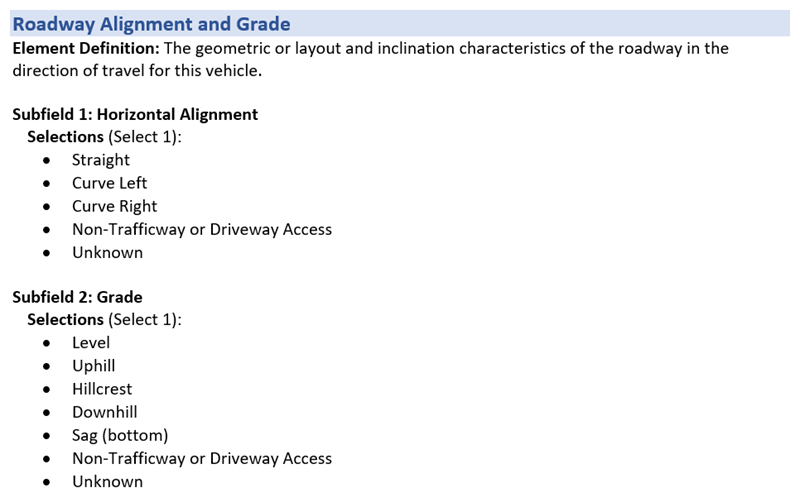
Please rate the following statements for this data element using a scale of 1-5, with 1 meaning Strongly Agree and 5 meaning Strongly Disagree.
|
1-Strongly Agree |
2-Agree |
3-Neutral |
4-Disagree |
5-Strongly Disagree |
This data element is clearly defined and understandable |
|
|
|
|
|
This data element can be collected at the scene of a crash |
|
|
|
|
|
This data element can be completed based on facts, not speculation |
|
|
|
|
|
This data element has a reasonable number of selections |
|
|
|
|
|
Reflecting on your answers above, could this data element be improved? If so, how?
Data Element Review: Transported to First Medical Facility By
Review the data element and answer the following questions.
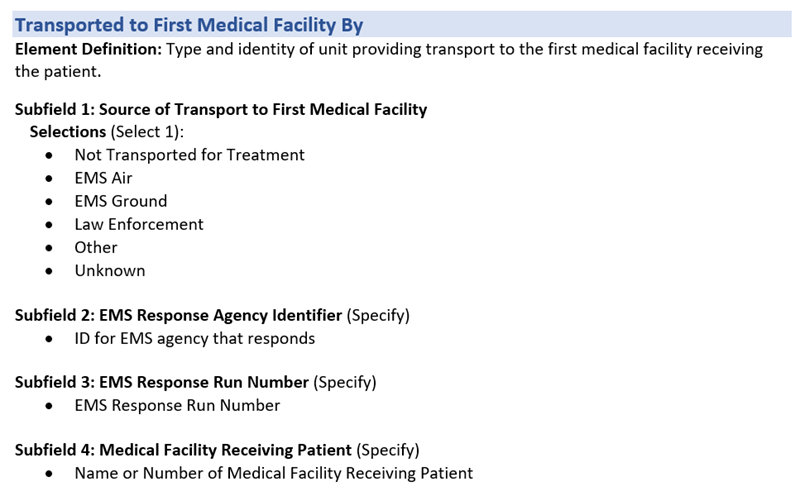
Please rate the following statements for this data element using a scale of 1-5, with 1 meaning Strongly Agree and 5 meaning Strongly Disagree.
|
1-Strongly Agree |
2-Agree |
3-Neutral |
4-Disagree |
5-Strongly Disagree |
This data element is clearly defined and understandable |
|
|
|
|
|
This data element can be collected at the scene of a crash |
|
|
|
|
|
This data element can be completed based on facts, not speculation |
|
|
|
|
|
This data element has a reasonable number of selections |
|
|
|
|
|
Reflecting on your answers above, could this data element be improved? If so, how?
Data Element Review: Vehicle Damage
Review the data element and answer the following questions.
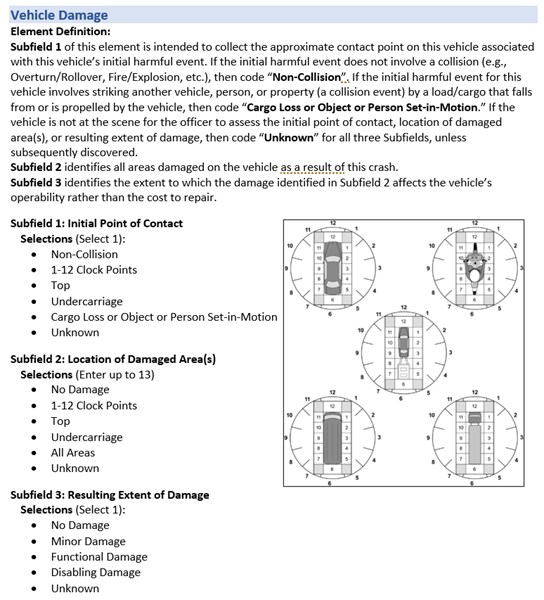
Please rate the following statements for this data element using a scale of 1-5, with 1 meaning Strongly Agree and 5 meaning Strongly Disagree.
|
1-Strongly Agree |
2-Agree |
3-Neutral |
4-Disagree |
5-Strongly Disagree |
This data element is clearly defined and understandable |
|
|
|
|
|
This data element can be collected at the scene of a crash |
|
|
|
|
|
This data element can be completed based on facts, not speculation |
|
|
|
|
|
This data element has a reasonable number of selections |
|
|
|
|
|
Reflecting on your answers above, could this data element be improved? If so, how?
Experience and Background
Number of years working as a Law Enforcement Officer writing traffic crash reports
Less than 1 year
1-3 years
4-6 years
7-9 years
10 or more years
Estimated number of crash reports completed in past 12 months
20 or Less
21-40
41-60
61-80
81 or more
Select all the types of crashes for which you have completed reports
crash with property damage only (no injuries)
crash with minor injury
crash with serious injury
crash with fatal injury
crash involving released hazardous material
crash with an alcohol-impaired driver
crash with drug-impaired driver
crash involving large vehicle or bus (FMCSA reportable)
crash involving bicyclist
crash involving pedestrian
crash involving motorcycle
Select the highest level of training you have received for completing traffic crash reports
Police academy only
Additional training upon entering traffic division
On the job training/mentoring
Periodic training (less often than annual)
Annual training
Regular training (more often than annual)
Advanced training in crash investigation and/or reconstruction
NHTSA Form 1675
| File Type | application/vnd.openxmlformats-officedocument.wordprocessingml.document |
| Author | Reed, Joanna (NHTSA) |
| File Modified | 0000-00-00 |
| File Created | 2023-09-03 |
© 2025 OMB.report | Privacy Policy